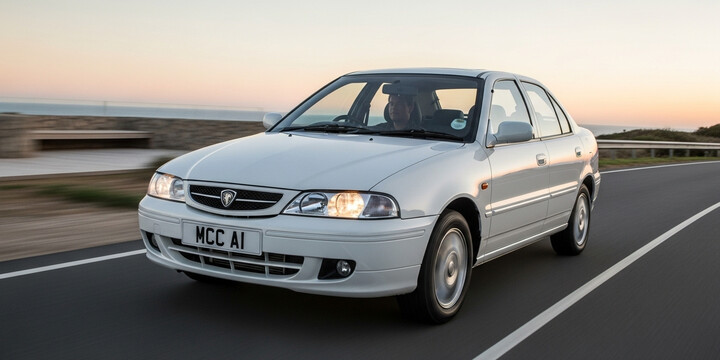
PROTON WIRA (2000-04) 4DR SALOON 1.3 LI
The PROTON WIRA (2000-04) 4DR Saloon 1.3 LI is a practical and budget-friendly compact sedan, well-suited for urban driving and everyday commuting in the UK. Known for its straightforward design and reliable performance, this model is a popular choice among first-time drivers, students, or those seeking a dependable car for local journeys. Its modest 1.3-litre engine delivers good fuel economy, making it an economical option to keep running costs low. With an average recorded mileage of around 65,000 miles and typically having about 2 to 3 previous keepers, the PROTON WIRA offers a reasonable balance of history and reliability.
What sets the PROTON WIRA apart in its class is its reputation for affordability and simple maintenance, making it an attractive choice for budget-conscious drivers or those looking for a first car. While it might not boast the latest tech or sporty features, its durable build and ease of handling make it a sensible alternative to similar models. If you're considering a used saloon that offers practicality and value, the PROTON WIRA (2000-04) 4DR Saloon 1.3 LI is worth exploring, especially for city driving or everyday errands.

average use

The data indicates that for the Proton Wira (2000-04) 4-door saloon 1.3L, the most recent mileage readings are broadly distributed across three ranges. Precisely, 40% of vehicles are recorded to have mileage between 70,000 and 80,000 miles, another 40% fall within the 60,000 to 70,000 miles range, and the remaining 20% are in the 20,000 to 30,000 miles bracket. This suggests that a significant portion of these vehicles tend to have accumulated between 60,000 and 80,000 miles, with relatively fewer vehicles reported at lower mileage levels.

vehicle values

The private sale valuation data for the Proton Wira (2000-04) 4-door saloon 1.3L indicates that vehicles in this category are generally valued at up to £1,000 in the UK marketplace. Notably, the data suggests a straightforward valuation approach, with a uniform estimate of 100% of the asking price falling within the £0 to £1,000 range. This highlights that Proton Wiras from this period are typically considered budget-friendly options, with little variation in private sale prices based on the available data.

production years

The data indicates that the majority of Proton Wira (2000-04) 4DR Saloon 1.3L vehicles in our sample were manufactured in 2001, accounting for 40%. Vehicles from 2000, 2002, and 2004 each make up 20% of the sample, suggesting a relatively even distribution across these years, with a notable peak in 2001. This pattern may reflect higher production or availability of vehicles from that year.

colour popularity

The data indicates that the most common main paint colour for the Proton Wira (2000-04) 4DR Saloon 1.3L is silver, accounting for 40% of the sample. Blue and green each make up 20%, while white also represents 20%. This suggests that silver is the predominant colour choice among these vehicles, with a roughly equal preference between blue, green, and white. The distribution reflects a diverse range of colours, though silver is notably the most popular.

ownership cycle

The data indicates that for the Proton Wira (2000-04) 4DR Saloon 1.3 LI, the majority of vehicles—specifically 60%—have had either 2 or 3 registered keepers, with 40% having 3 keepers and 20% having 2 keepers. Additionally, 20% of the vehicles have only 1 registered keeper, and another 20% have 4 registered keepers. This suggests a relatively frequent turnover in ownership, especially around the 2- and 3- keeper marks, which could point to moderate vehicle usage or ownership changes over time.

engine choices

The data indicates that all Proton Wira (2000-04) 4DR Saloon 1.3 LI vehicles are equipped with a 1.3-litre engine and are exclusively petrol-powered. This suggests a consistent engine specification and fuel type for this model within the given data set, reflecting uniformity in design and fuel choice for these vehicles.












